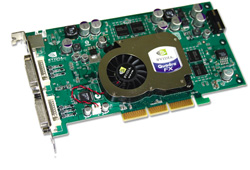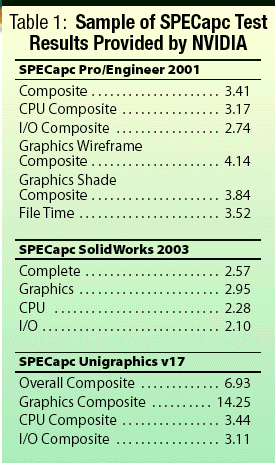Reasonably Priced Power—NVIDIA Quadro FX 1100
This mid-range board outshines some high-end competition.
Latest News
December 4, 2001
By David Cohn
NVIDIA recently sent DE its Quadro FX 1100, an attractively priced mid-range graphics accelerator board based on the company’s fifth-generation workstation graphics architecture. The entire new Quadro FX family is targeted specifically at users of CAD, CAM, and digital content creation software, and the FX 1100 in particularlooks like a perfect choice for mid-range MCAD applications.
For our review, we installed the FX 1100 in the same xw4100 workstation from Hewlett-Packard (Palo Alto, CA; website) we had previously reviewed (see Desktop Engineering, September 2003). HP originally provided this system to us with an NVIDIA Quadro 4 980 XGL graphics board in its AGP slot. Swapping the boards gave us an ideal opportunity to judge for ourselves the performance improvement, since the FX 1100 effectively replaces the 980 XGL in the NVIDIA lineup.

The newer NVIDIA board requires more power than the older 980 XGL. While this power is delivered automatically when the card is installed in an AGP Pro slot, the FX 1100 has a separate power connector for those systems, like the xw4100, with the more common standard AGP slot. All we needed to do to get up and running was attach one of the available 4-pin drive bay power connectors from the computer’s power supply.
The FX 1100 is an AGP 8X board featuring three parallel vertex engines, an on-chip vertex cache, and eight programmable pixel pipelines coupled to a high-speed DDR2 graphics DRAM bus with 128MB of memory and a graphics memory bandwidth of 10.4GB per second. This advanced technology enables the card to achieve 3D primitive performance of 100 million lit and textured triangles per second and a fill rate of 3.4 billion texels per second. The board also features a 128-bit memory interface to maintain high accuracy and 12 bits of subpixel precision. The high sub-pixel precision enables the board to more accurately map objects to pixel values, reducing the number of artifacts and visual anomalies. The FX architecture also supports both line and full-scene antialiasing (FSAA) and accelerates antialiased points and lines in hardware. It supports up to 16X FSAA at up to the board’s maximum 3840 3 2400 resolution. 
Unfortunately, we didn’t have a monitor available to perform tests at that resolution. Instead, we judged performance at a more reasonable 1280 3 1024 (our standard resolution for all such tests) on a single monitor. Like most modern mid-range and high-end boards, the FX 1100 provides two DVI-I connectors as well as a female 3-pin VESA-standard mini-DIN stereo sync output connector. Supported resolutions range from 640 3 480 at refresh rates from 60Hz to 250Hz all the way up to 3840 3 2400 (a resolution only possible at a 13Hz interlaced refresh rate). The maximum resolution we could achieve was 2048 3 1536 at 60Hz. All resolutions support True Color 32-bit display.
NVIDIA supplied some sample benchmark test results for reference, shown in Table 1. To judge for ourselves, however, we ran a number of the SPECapc graphics performance benchmarks, including the latest SPECviewperf 7.1.1. Since we had previously tested this HP workstation equipped with the 980 XGL board using earlier versions of this benchmark as well as an earlier version of the SPECapc test using SolidWorks 2001 Plus, we repeated them with the FX 1100 board. The SPECviewperf performance improved by as much as 60 percent. Our test results, comparing the two boards, are shown in the accompanying Table 2.
We also connected a second monitor and made use of NVIDIA’s nView multi-display technology. nView incorporates built-in attribute and performance tuning for each type of display device and controls that let you choose optimum settings for your particular application. NVIDIA also supplies custom application drivers, such as MAXtreme for 3ds max and PowerDraft for AutoCAD. And the company’s Unified Driver Architecture (UDA) allows every generation of Quadro FX products to use any certified driver.
 Don’t Break the Bank
Don’t Break the Bank Those looking to upgrade to the FX 1100 should note that the company, although a dominant force in both the high-end and consumer graphics card markets, doesn’t sell directly to end-users. Instead, its boards come bundled with a PC or are sold by resellers and VARs, such as PNY Technologies (Parsippany, NJ; website).
A quick search revealed an average street price for the FX 1100 of $650, making it an excellent choice for mid-range CAD workstations. Though not quite as fast as NVIDIA’s high-end FX 3000, it also won’t break the bank. The new board offers significant performance improvements over the Quadro 980 XGL and even outperforms some high-end boards. MCAD users will want to consider the NVIDIA Quadro FX 1100 as either an upgrade or a graphics accelerator of choice.
David Cohn, a computer consultant and technical writer based in Bellingham, WA, has been benchmarking PCs since 1984. He’s a contributing editor to DE and publisher of Engineering Automation Report. You can contact him by sending an e-mail to reader feedback.
Company and Product Information Requirements:- Intel Pentium III or AMD Athlon class CPU (min.)
- Microsoft Windows XP, Windows 2000, or Linux (full OpenGL implementation, complete with NVIDIA and ARB extensions; complete XFree 86 drivers)
- One available AGP 2.0-compliant slot or better
- 350W power supply with one available drive bay power connector
- 128MB system memory minimum 20MB free hard disk space for driver software
- Resolution up to 2048 3 1536 at 60Hz (3840 3 2400 at 13Hz interlaced) 128MB DDR memory
Two 29-pin DVI-I output connectors, one 3-pin mini-DIN stereo sync output connector
NVIDIA Corp.
408-615-2500
website
Subscribe to our FREE magazine, FREE email newsletters or both!
Latest News
About the Author
David Cohn is a consultant and technical writer based in Bellingham, WA, and has been benchmarking PCs since 1984. He is a Contributing Editor to Digital Engineering, the former senior content manager at 4D Technologies, and the author of more than a dozen books. Email at [email protected] or visit his website at www.dscohn.com.
Follow DE





